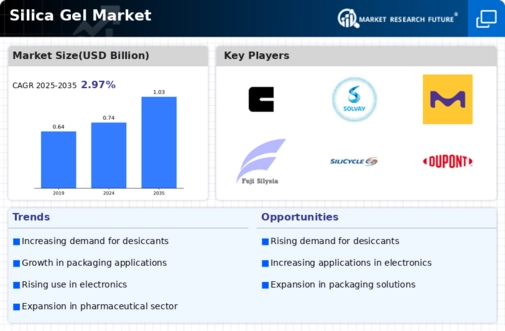Silica Gel Size
Silica Gel Market Growth Projections and Opportunities
The silica gel market is influenced by several market factors that play a crucial role in shaping its dynamics. One of the primary factors affecting this market is the demand from various end-use industries. Silica gel is widely used in industries such as pharmaceuticals, electronics, food and beverages, and petrochemicals. The growing demand for silica gel in these industries, particularly in emerging economies, drives market growth. For example, in the pharmaceutical industry, silica gel is used as a desiccant to control moisture levels in packaging, thus preserving the quality of drugs and extending their shelf life.
A granular, porous, vitreous form of silicon dioxide largely made from synthetics processing from sodium silicate is called silica gel. It has various non-porous liquid-like microstructures but it is commonly used in dried form and hence the other name is silica xerogel.
Another market factor that affects the silica gel market is technological advancements and innovations. Manufacturers are constantly investing in research and development activities to improve the quality and performance of silica gel products. This includes developing new formulations, enhancing moisture absorption capacity, and exploring novel applications. These technological advancements not only help companies stay competitive but also open up new opportunities in niche markets.
The availability and cost of raw materials also play a significant role in the silica gel market. Silica gel is primarily made from sodium silicate, which is derived from silica sand. Fluctuations in the prices of silica sand and other raw materials can impact production costs and, subsequently, product pricing. Additionally, the availability of raw materials can be affected by factors such as environmental regulations, mining restrictions, and geopolitical tensions, all of which can influence market dynamics.
Market competition is another important factor shaping the silica gel market. The market is highly competitive, with numerous manufacturers vying for market share. Companies compete based on factors such as product quality, price, brand reputation, and distribution network. Additionally, the presence of both established players and new entrants intensifies competition, leading to innovations and price competitiveness in the market.
Regulatory factors also play a crucial role in the silica gel market. Silica gel is subject to various regulations and standards imposed by government agencies and industry bodies. These regulations govern aspects such as product safety, labeling requirements, and environmental compliance. Compliance with these regulations is essential for manufacturers to ensure market acceptance and avoid legal repercussions.
Market trends and consumer preferences also influence the silica gel market. For example, the growing awareness about the importance of moisture control in preserving product quality has led to increased demand for silica gel in various applications. Similarly, the rising popularity of eco-friendly and sustainable products has prompted manufacturers to develop environmentally friendly silica gel alternatives, such as biodegradable desiccants.
Furthermore, macroeconomic factors such as economic growth, inflation, and currency exchange rates can impact the silica gel market. Economic downturns may lead to reduced consumer spending and lower demand for silica gel products, while favorable economic conditions can drive market growth. Similarly, fluctuations in currency exchange rates can affect the competitiveness of silica gel products in international markets.



 Source: Secondary Research, Primary Research, Market Research Future Database, and Analyst Review
Source: Secondary Research, Primary Research, Market Research Future Database, and Analyst Review






Leave a Comment